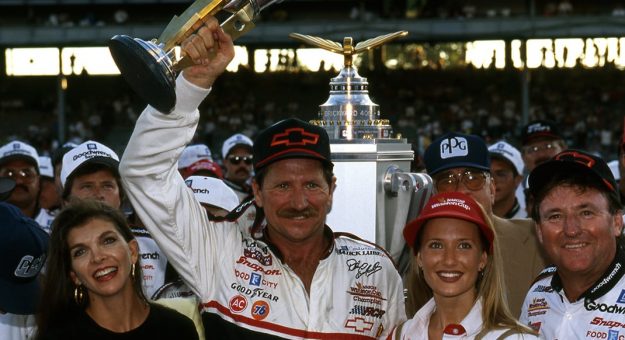On Saturday night before the 500, Earnhardt drove NFL legend and Daytona 500 grand marshal Terry Bradshaw around the speedway in a pace car. He spun the car on pit road and stood with Bradshaw on the car’s hood in a mock victory lane celebration. Earnhardt was jovial, excited and relaxed with the Daytona 500 fewer than 16 hours away.
Sunday, Feb. 18, 2001, dawned to a pleasant Florida breeze as race fans sat in lines of traffic entering the speedway during the early morning hours. Crews made last-minute preparations in the garage area before eventually pushing their cars to pit road.
Earnhardt attended the mandatory drivers’ meeting before changing into his trademark GM Goodwrench colors and finding a comfortable chair outside his motorhome. He appeared relaxed and at peace.
Matt Yocum, a pit reporter for FOX Sports, interviewed Earnhardt twice on race morning and remembers his laugh and easygoing manner.
“When you look at Dale at any Speedweeks, he always had a bigger confidence in his step,” Yocum said. “To me, it was always like getting close to Christmas when you’re a little kid. That’s the type of happiness that he had. He had that special energy when he came to Daytona.
“He told me in 1997 that his first recollection of Daytona was when hisdad, Ralph, would come back from racing on the beach with sacks of oranges. His love affair with Daytona began early and he always had a special connection — something larger there. When I interviewed him about an hour before the race, he was so calm and so at peace. But that pretty much mirrored his entire Speedweeks in a way.”
Even though restrictor-plate races at Daytona are never predictable, Earnhardt eerily predicted Michael Waltrip and Earnhardt Jr., who were driving cars Earnhardt owned, would be up front with him battling for the victory.
Fourteen drivers swapped the lead 49 times with Earnhardt leading 17 tours of the 2.5-mile track. During the final circuits, Earnhardt was third behind Waltrip and Earnhardt Jr.
FOX announcers Mike Joy, Darrell Waltrip and Larry McReynolds noticed Earnhardt blocking those behind him, something he rarely did.
As Michael Waltrip and Earnhardt Jr. steamed toward the checkered flag, Dale Earnhardt and Sterling Marlin made slight contact, sending Earnhardt’s car into the turn-four wall. The passenger side of Earnhardt’s car was also collected by Ken Schrader’s Pontiac with a second unavoidable hard blow.
Schrader ran to Earnhardt’s car and frantically signaled for rescue workers, realizing the gravity of Earnhardt’s injuries. Immediate life-saving procedures were performed as rescue workers cut away the car’s top. After being removed from the wreckage, Earnhardt was taken to Halifax Medical Center.
The Benny Kahn Press Room was crowded with media members from around the world who there to cover the race. Deadlines were fast approaching, and official word was needed on Earnhardt’s condition. When NASCAR’s top executives entered the room, their faces told a bleak story. NASCAR President Mike Helton approached the podium.
“This is undoubtedly the toughest announcement I’ve ever had to make. After the accident in turn four at the end of the Daytona 500, we’ve lost Dale Earnhardt,” Helton said.
For NASCAR officials, media and fans, the hours that followed were a blur of shock and disbelief. Crew members and fans openly wept. Media members worked to get their stories complete, numb to what they were writing or saying while not allowing themselves to break down.
Not since the death of Ayrton Senna on May 1, 1994, during the San Marino Grand Prix at the Autodromo Enzo e Dino Ferrari in Italy had the motorsports world suffered such an emotional blow.
It was determined that Earnhardt died of a basal skull fracture and also suffered broken ribs, a broken ankle and broken breastbone. Officials eventually reported his left-side lap belt had not been properly installed and tore loose during the crash.
Earnhardt was buried during a private ceremony near his home on Feb. 21, the following day 3,000 members of the racing community gathered at the Calvary Church in Charlotte to remember the seven-time champion.
Following Earnhardt’s death, professional stock car racing underwent a dramatic change. Some safety improvements were a direct result of things learned from his accident while others were made simply through the evolution of the sport.
Over the following months, the HANS device was widely distributed to address basal skull fractures and NASCAR opened a research-and-development center in Concord, N.C., where engineers designed an all-new car, known as the Car of Tomorrow. It was built to better absorb impacts and protect the driver through the use of larger seats with wrap-around head padding and better driver restraints.
Numerous other changes related to safety have made by NASCAR over the past two decades.
Today, when asked about the crash, Childress says, “There isn’t a day that goes by that I don’t think about him. He was my closest friend and my hunting buddy. I really, really miss him.”
